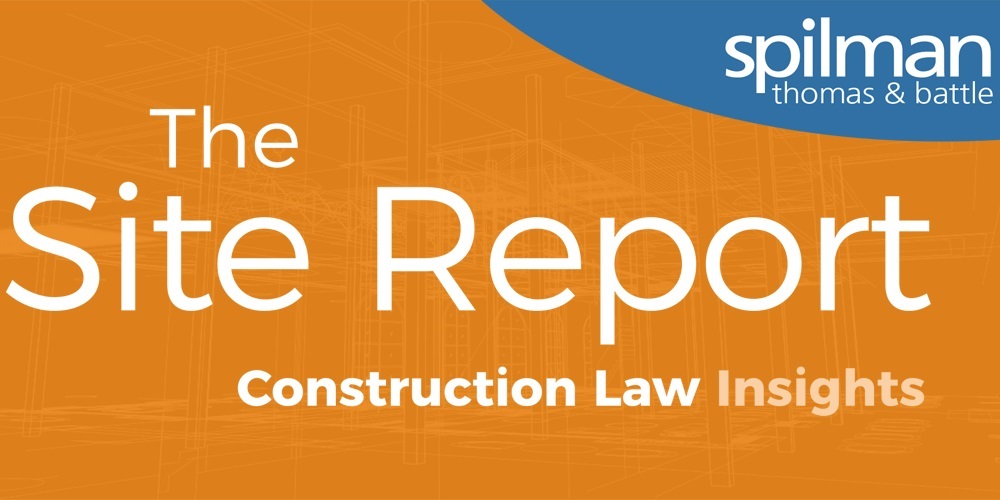Article
Resources
expect
Article
Insights
Highlights from North Carolina’s 43rd State Construction Conference
March 12, 2024

On March 7, 2024, approximately 1,200 members of the construction industry participated in NC’s 43rd State Construction Conference in Raleigh, North Carolina. In case you missed the Conference, Spilman attorneys Stephanie Eaton and Steven Hemric provide the following highlights:
- Building Code Changes Planned For 2025
- 2024 NC State Building Code tentatively goes into effect January 2025
- The following provisions are changing:
- Atriums – revised definition (Sec. 202) and smoke control requirements (Sec. 404.5)
- Occupied Roofs – extension of fire alarm systems; standpipe systems for landscaped roofs; clarification that roof space is not another story if not enclosed and does not affect building height (Sec. 503.1.4; Sec. 1006.2.1; Sec. 1006.3)
- Energy Storage Systems (ESS) – fire-prevention/control related code changes (Sec. 707, 716; IFC 1207)
- Parking Garages – addition of sprinkler systems for certain sized garages to address increase of plastics and EVs in autos
- Educational Facilities – changes address mass notification for higher education facilities (Sec. 917.1), lab suites, with number of such suites reduced as you proceed through the building (sec. 428 and IFC Chapter 38) (Table 307 now Table 428.3), means of egress illumination (Sec. 1008.3.3), locks and latches (Sec. 1010.2), occupant load classification (Table 1004.5), atriums (3 excepts to smoke control) (Sec. 404.6), fire resistance table moved from chapter 6 to chapter 7
- New Types of Construction – Types IV-A, IV-B, IV-C (Sec. 602.4.1 and 602.4.3) (mass timber and heavy timber construction) – addresses increased use of laminate floor and wall systems)
- Accessibility Requirements – A117.1-2017 – wheelchair turn radius increasing from 60” to 67” and clear length increasing from 48” to 52”
- EV Stations – Sect. 1107 requires a minimum of 5 percent of each type accessible
- Temporary Structures and Event Structures – Sec. 3103.1 and 202
- Energy Conservation Code – moving to 2021 IECC; revised energy zoning maps
- Building Envelope – air barriers and daylight controls – new section C405.2.4
- 2024 NCBEC changes accessibility for existing buildings
- Exterior Wall Coverings (Sect. 309) in effect if building is 2 stories or higher
- Building Code Council Update
- House Bill 488/Session Law 2023-108 separates the Building Code Council into the Building Code Council for commercial construction and the Residential Building Code Council for residential construction as of 1/1/25
- Residential code will address how to construct 3- and 4-family units, in addition to duplexes and single-family units
- Local jurisdictions won’t require Commercial Building Code Summary-Appendix B (though state projects will still require Appendix B)
- HUB Update
- Definition of what type of company can become HUB-certified now includes companies with 51 percent or more of Employee Stock Ownership Plans owned by minority or disabled persons
- New reporting system (HUBSCO+) and new e-vendor portal (eVP)
- New Laws
- Effective January 24, 2024, the Uniform Flood Plain Management Policy was updated to increase resiliency, protect property investments, and encourage nature-based solutions for construction in flood plain areas.
- Executive Order 305 was recently signed to protect and restore natural areas, including forests, wetlands, and parks.
- State Capital and Infrastructure Fund (SCIF)
- SCIF implements “pay as you go” capital funding policy to cash flow projects over time
- GREAT is the broadband expansion program
- Expects 3.5 percent budget expansion
- Contractors need to stay on schedule and within the budget
- State Construction Office Updates
- Currently has $11 Billion and 7,356 active projects
- Relocating to Albemarle Building in Raleigh
- 2024 is the “year of public schools”
- Construction Industry Economic Update
- Construction product prices remain volatile and supply chain issues remain with certain products (e.g., switch gear and transformers, cement)
- Allow for 4-6 percent increase for material costs and 5-7 percent increase in average hourly earnings costs
- Construction spending up an average of 12 percent
- New construction of utility-scale solar and battery facilities is increasing, as are construction for data centers
- Health care construction spending overall is up an average of 13 percent
- K-12 construction outlook is bright, while higher education construction outlook is not strong
- Federal funds are available for highway, waste/stormwater, and broadband projects
336.631.1062
336.631.1063



